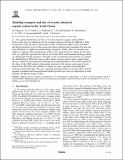| dc.contributor.author | McClelland, J. W. | |
| dc.contributor.author | Menemenlis, Dimitris | |
| dc.contributor.author | Townsend-Small, A. | |
| dc.contributor.author | Peterson, B. J. | |
| dc.contributor.author | Manizza, Manfredi | |
| dc.contributor.author | Dutkiewicz, Stephanie | |
| dc.contributor.author | Hill, Christopher N. | |
| dc.contributor.author | Follows, Michael J | |
| dc.date.accessioned | 2015-07-22T18:26:50Z | |
| dc.date.available | 2015-07-22T18:26:50Z | |
| dc.date.issued | 2009-10 | |
| dc.date.submitted | 2009-06 | |
| dc.identifier.issn | 08866236 | |
| dc.identifier.uri | http://hdl.handle.net/1721.1/97888 | |
| dc.description.abstract | The spatial distribution and fate of riverine dissolved organic carbon (DOC) in the Arctic may be significant for the regional carbon cycle but are difficult to fully characterize using the sparse observations alone. Numerical models of the circulation and biogeochemical cycles of the region can help to interpret and extrapolate the data and may ultimately be applied in global change sensitivity studies. Here we develop and explore a regional, three-dimensional model of the Arctic Ocean in which, for the first time, we explicitly represent the sources of riverine DOC with seasonal discharge based on climatological field estimates. Through a suite of numerical experiments, we explore the distribution of DOC-like tracers with realistic riverine sources and a simple linear decay to represent remineralization through microbial degradation. The model reproduces the slope of the DOC-salinity relationship observed in the eastern and western Arctic basins when the DOC tracer lifetime is about 10 years, consistent with published inferences from field data. The new empirical parameterization of riverine DOC and the regional circulation and biogeochemical model provide new tools for application in both regional and global change studies. | en_US |
| dc.description.sponsorship | National Science Foundation (U.S.) | en_US |
| dc.language.iso | en_US | |
| dc.publisher | American Geophysical Union (AGU) | en_US |
| dc.relation.isversionof | http://dx.doi.org/10.1029/2008gb003396 | en_US |
| dc.rights | Article is made available in accordance with the publisher's policy and may be subject to US copyright law. Please refer to the publisher's site for terms of use. | en_US |
| dc.source | MIT web domain | en_US |
| dc.title | Modeling transport and fate of riverine dissolved organic carbon in the Arctic Ocean | en_US |
| dc.type | Article | en_US |
| dc.identifier.citation | Manizza, M., M. J. Follows, S. Dutkiewicz, J. W. McClelland, D. Menemenlis, C. N. Hill, A. Townsend-Small, and B. J. Peterson. “Modeling Transport and Fate of Riverine Dissolved Organic Carbon in the Arctic Ocean.” Global Biogeochemical Cycles 23, no. 4 (October 7, 2009): n/a–n/a. © 2009 American Geophysical Union | en_US |
| dc.contributor.department | Massachusetts Institute of Technology. Center for Global Change Science | en_US |
| dc.contributor.department | Massachusetts Institute of Technology. Department of Earth, Atmospheric, and Planetary Sciences | en_US |
| dc.contributor.mitauthor | Manizza, Manfredi | en_US |
| dc.contributor.mitauthor | Follows, Michael J. | en_US |
| dc.contributor.mitauthor | Dutkiewicz, Stephanie | en_US |
| dc.contributor.mitauthor | Hill, Christopher N. | en_US |
| dc.relation.journal | Global Biogeochemical Cycles | en_US |
| dc.eprint.version | Final published version | en_US |
| dc.type.uri | http://purl.org/eprint/type/JournalArticle | en_US |
| eprint.status | http://purl.org/eprint/status/PeerReviewed | en_US |
| dspace.orderedauthors | Manizza, M.; Follows, M. J.; Dutkiewicz, S.; McClelland, J. W.; Menemenlis, D.; Hill, C. N.; Townsend-Small, A.; Peterson, B. J. | en_US |
| dc.identifier.orcid | https://orcid.org/0000-0002-3102-0341 | |
| mit.license | PUBLISHER_POLICY | en_US |
| mit.metadata.status | Complete | |
